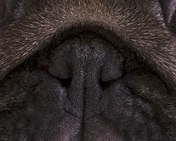Respiratory Function in Brachycephalic Dogs – Croney Research Group

Brachycephalic obstructive airway syndrome (BOAS)
Brachycephalic obstructive airway syndrome is a group of different abnormalities that may be observed in brachycephalic dog breeds. The key abnormalities include:
- Stenotic nares: The nares, or nostrils, are smaller and narrower in some brachycephalic dogs. Stenotic nares make it harder for air to flow when dogs are breathing.
- Hypoplastic trachea: The soft palate is tissue at the back of the roof of the mouth. In brachycephalic dogs, this tissue may be longer than normal, blocking the windpipe at the back of the throat.
- Everted laryngeal saccules: The larynx (or voice box) contains tissue (small sacs) which can expand and turn inside out (evert) when a dog is breathing heavily. The saccules can block the trachea and airway when everted, making it even harder for the dog to breathe.
- Elongated soft palate: A hypoplastic trachea (or windpipe) is narrower than normal.
- Laryngeal collapse: The larynx becomes stressed by other aspects of respiratory dysfunction and cannot open as wide as is normal.
Common signs of BOAS
|
|
How is BOAS diagnosed?


Dogs with normal (top image) and stenotic (lower image) nares
BOAS is diagnosed based on a physical exam and clinical signs. Stenotic nares are visually apparent, as they are much smaller than those of a non-brachycephalic dog (see photos). Diagnosing other abnormalities, such as an elongated palate or everted saccules, requires that the dog be placed under anesthesia.
Respiratory Function Grading
A new Respiratory Function Grading Scheme has been developed to assess how well dogs are breathing. The assessment assigns a score from 0 to 3. Dogs assigned a 0 or 1 are mildly affected and should be monitored for changes in signs. Dogs assigned a 2 or 3 experience more severe signs and may need treatment. Dogs assigned a 3 should not be bred as their puppies will likely be affected by BOAS as well.
Treatment and management of BOAS
Surgery to correct abnormalities can improve breathing for some dogs. Stenotic nares can be adjusted by removing tissue and increasing the size of the nares. An elongated palate can be shortened, and everted saccules can be removed from the larynx.
Brachycephalic dogs should be kept at a healthy weight, as obesity can make signs worse. Exercise, especially on hot or humid days, should be carefully monitored to prevent overheating.
Because a regular collar adds strain to the windpipe, brachycephalic dogs should be walked with a harness instead.


How can I help the dogs in my breeding program?
If you breed brachycephalic dogs, have their respiratory function assessed by a qualified veterinarian.
Your veterinarian can help you make breeding decisions based on your dog’s health and physical signs. The goal is to reduce the risk of passing on traits, such as extremely stenotic nares, to puppies and your future breeding dogs.
For more information...
Information about OFA screening, including a list of veterinarians who can perform the Respiratory Function Grading assessment: ofa.org/diseases/rfgs/
Topic(s): Bare Bones Basics, Breeder Resource, Dog Welfare, Reproductive Healthcare, Welfare